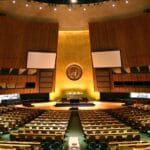After bin Laden: Nuclear terrorism still a top threat
By Fissile Materials Working Group | May 13, 2011
Osama bin Laden’s death may represent a significant turning point in the US effort to defeat Al Qaeda, but the threat of nuclear terrorism will not lessen in the wake of his demise. Such threats, however, are preventable, and the United States must now take care to sustain the nonproliferation and threat reduction programs that will help stop terrorists from obtaining nuclear materials.
More than a decade ago, Osama bin Laden professed that “acquiring [chemical or nuclear] weapons is a religious duty.” Since then, Al Qaeda operatives and leaders have restated their intention to acquire a nuclear capability.Experts broadly agree that Al Qaeda does not possess a nuclear device; however, it is generally accepted that it and other terrorist organizations continue to seek the materials necessary to build one. Two years ago in his landmark speech in Prague, President Barack Obama made securing “all vulnerable nuclear material around the world within four years” a top priority. Earlier this year, Director of National Intelligence James Clapper reiterated the importance of the administration’s commitment to the four-year goal in his testimony before the Senate Committee on Armed Services, noting that “poorly secured stocks of CBRN [chemical, biological, radiological, and nuclear materials] provide potential source material for terror attacks.” Significant progress has been made in US efforts to secure nuclear material around the globe, but much remains to be done.
The evolving threat. While Al Qaeda’s anti-American ideology is unlikely to change after bin Laden’s death, the loss of the group’s founder and figurehead could affect Al Qaeda’s structure. According to the Atlantic Council’s J. Peter Pham, regional “branches” and “franchises” of the terrorist organization gained power during the decade that bin Laden was in hiding, and while united by their loyalty to Al Qaeda’s mission, they are not necessarily subject to orders from a central leadership.
The growing influence, strength, and operational capacity of these regional organizations (Al Qaeda in the Arabian Peninsula and Al Qaeda in the Islamic Maghreb, for example) are of particular concern with respect to the threat of nuclear terrorism. The best way to prevent Al Qaeda subgroups — ideologically aligned, geographically disparate, and operating under regional leadership — from gaining access to nuclear material is to secure existing sites and eliminate superfluous storage sites. Enough nuclear material to make tens of thousands of nuclear devices exists in dozens of locations worldwide. Without being able to predict how bin Laden’s death might alter the operational capacity of Al Qaeda, a US priority must be securing this potential source material.
Support proven programs. Efforts to eliminate and secure nuclear material are the best way to minimize the threat of nuclear terrorism: Prevent terrorist groups from acquiring the materials necessary for a nuclear device, and nuclear terrorism is prevented. In the post–bin Laden era, existing programs that seek to lock down vulnerable nuclear material must remain a key part of US national security strategy.
Effective nonproliferation programs that aim to keep nuclear material out of terrorists’ hands must be continued and their role in the four-year effort to secure vulnerable material supported. These programs are successful, but they require continued financial support from Congress to keep pace with recent accomplishments. The National Nuclear Security Administration (NNSA) secured 800 bombs’ worth of nuclear material in 2010 alone. Since April 2009, the NNSA’s Global Threat Reduction Initiative (GTRI) has eliminated highly enriched uranium (HEU) from six countries, and the initiative is on track to secure or remove all of the vulnerable weapons-usable nuclear material that has been identified at civilian sites around the globe by 2016 — more than 4,800 kilograms.
One of GTRI’s more remarkable achievements to date was the removal of HEU from Chile in the aftermath of an 8.8-magnitude earthquake in April 2010. The material may not have been a likely terrorist target, but the coordinated US effort to remove it during a crisis situation was an achievement that strengthened both US and global security. The coordinated US raid on a compound in Pakistan rid the world of a terrorist mastermind and likewise improved US and global security. To make the most of that mission’s success, continued financial and political support must be given to the lesser-known actions that make nuclear terrorism less likely.
Nuclear nonproliferation and threat reduction programs represent the means by which Washington can prevent fissile materials from becoming the tools of terrorists and are crucial to post–bin Laden counterterrorism strategy. An accomplishment on one front of the fight against Al Qaeda must not give way to complacency on another.
Editor’s Note: Sarah Williams, coordinator of the Fissile Materials Working Group, wrote this column. Williams is also a Herbert Scoville Jr. Peace Fellow at the Center for Science, Technology, and Security Policy (CSTSP) at the American Association for the Advancement of Science (AAAS). Her comments do not reflect the opinions or position of the CSTSP or AAAS.
Together, we make the world safer.
The Bulletin elevates expert voices above the noise. But as an independent nonprofit organization, our operations depend on the support of readers like you. Help us continue to deliver quality journalism that holds leaders accountable. Your support of our work at any level is important. In return, we promise our coverage will be understandable, influential, vigilant, solution-oriented, and fair-minded. Together we can make a difference.
Topics: Columnists, Nuclear Weapons















